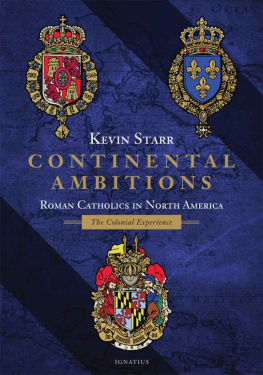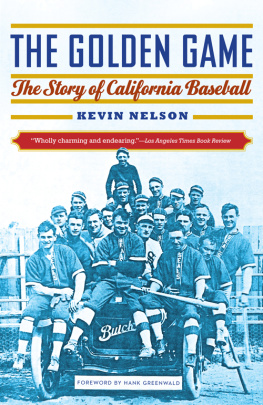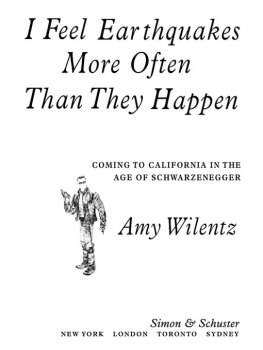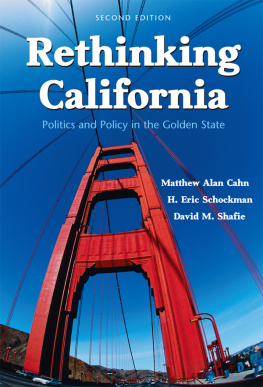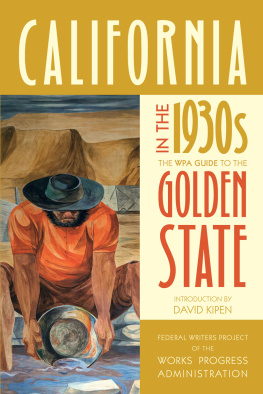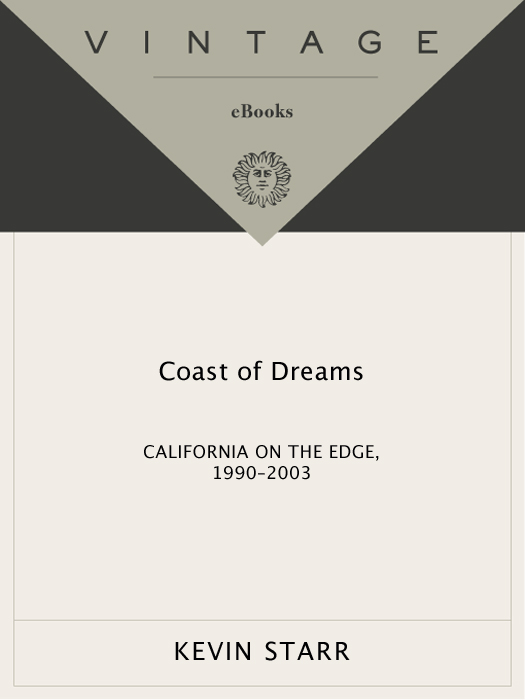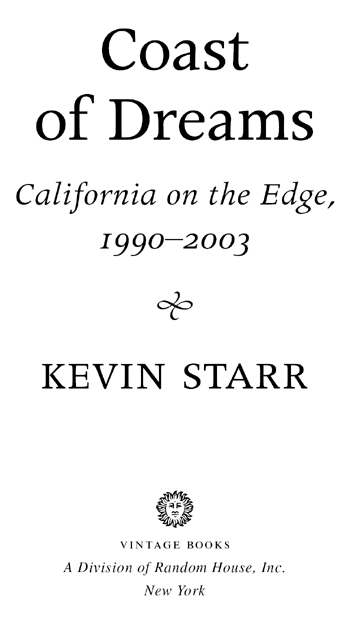Acclaim for Kevin Starrs
Coast of Dreams
Indispensable. Starr has written not so much a recent history as an almanac. Its a snapshot of contemporary Californiawith the shutter left open for 13 years.
San Francisco Chronicle
Encyclopedic. Starr enlivens the text with his punchy, pacy prose. And from this kaleidoscope of essays emerges a profile of California that brings, alternately, despair and exhilaration.
The Daily Telegraph
Impressive. Starr writes as both historian and journalist. No one else knows more about California.
The New York Times
Coast of Dreams covers Californias restaurant scene, art, architecture, the states fiscal crises, its ecological and urban battles, the wedge issues of immigration and affirmative action, [and] the swimwear preferences of Santa Barbara versus those of Palm Springs. All this and much more is packed into short, action-packed chapters which jump from issue to issue within broadly themed sections.
The Observer
Starr discerns a fascinating state culture that alternately inspires Californians with bold visions and entraps them in seductive illusions. Starr illuminates ideals and espouses pipe dreams that will matter to readers all across the country.
Booklist (starred review)
Its ambitious scope alone makes it worth reading. Its striking how much social and cultural detail he captures.
The Sacramento Bee
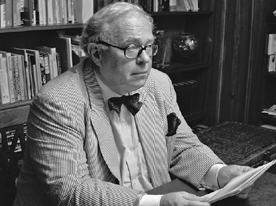
KEVIN STARR
Coast of Dreams
Kevin Starr is University Professor of History at the University of Southern California in Los Angeles. From 1994 to 2004, he served as the state librarian for California. His writing has won a Guggenheim Fellowship and gold and silver medals from the Commonwealth Club of California. He divides his time between San Francisco and Los Angeles.
ALSO BY KEVIN STARR
Americans and the California Dream Series
Americans and the California Dream, 18501915
Inventing the Dream:
California Through the Progressive Era
Material Dreams:
Southern California Through the 1920s
Endangered Dreams:
The Great Depression in California
The Dream Endures:
California Enters the 1940s
Embattled Dreams:
California in War and Peace, 19401950
Lands End, A Novel
Over California,
photography by Reg Morrison
O California!
Nineteenth and Early Twentieth Century California Landscapes
and Observations, with Stephen Vincent and Paul Mills
FIRST VINTAGE BOOKS EDITION, FEBRUARY 2006
Copyright 2004 by Kevin Starr
All rights reserved. Published in the United States by Vintage Books, a division of Random House, Inc., New York, and in Canada by Random House of Canada Limited, Toronto. Originally published in hardcover in the United States by Alfred A. Knopf, a division of Random House, Inc., New York, in 2004.
Vintage and colophon are registered trademarks of Random House, Inc.
The Library of Congress has cataloged the Knopf edition as follows:
Starr, Kevin.
Coast of dreams : California on the edge, 19902003 / Kevin Starr.
p. cm.
1. CaliforniaHistory1950. 2. CaliforniaEconomic
conditions20th century. I. Title.
F866.2.S73 2004
979.4053dc22 2003060577
eISBN: 978-0-307-79526-7
Author photograph Jessica Marple
www.vintagebooks.com
v3.1
For Sandra Dijkstra, Ashbel Green, Bruce Harris, and Sheldon Meyer
CONTENTS
Holy Land or Plains of Id? Southern California
and Metro Sacramento
The Upper Left: Berkeley, Santa Monica,
West Hollywood
Booming Places: Ventura, Los Angeles,
San Bernardino, and San Diego Counties
PREFACE
California on the Edge
A s a writer who had dedicated the best part of his life and writing career to chronicling California, I became fascinated as the 1980s turned into the 1990s by the possibilitysometimes the probabilitythat California had gone seriously awry. I sensed this possibility most vividly in the epidemic of gang-related homicides and the attendant violence that seemed to pervade Los Angeles County. That foreboding became even more actualized as I lived through the Los Angeles riots of April and May 1992 and had my life altered by the Northridge earthquake of January 1994. As a more than occasional journalist and avid reader of newspapers, I became increasingly aware of the dark and somber picture of California that was emerging from Californias coverage of itself. As someone attuned primarily to the imaginative dimension of social experience and to the moral drama of California as an American experiment, I became increasingly disturbed by the grim realities around me.
While a graduate student at Harvard in the 1960s, I had decided to devote my writing career to chronicling California as an essential and compelling component of the larger American experience. By the early 1990s, I was beginning to wonder whether I had chosen a dead end. Was California an aberration, a sideshow, or, worse, a case study in how things could go wrong for the United States? Such questions were of more than passing importance to me, in that I had invested most of my professional energies in California in the belief that the history of California was mainstream American history. Even more, I had extended, enhanced, even shored up, my personal identity by projecting my own hopes, dreams, and aspirations onto California. Had I made a terrible mistake?
Despite such reservations, however, I continued to enjoy and participate in many of the liberating aspects of life in the Golden State. Having been frequently attacked as a California booster, I did notas so many others were doing at this timebecome a California basher. As a classroom teacher at the University of Southern California and, later, as state librarian of California, I was encountering more than enough evidence that there was still something compelling about the California experiment: its ecumenism, for one thing; its embrace of the planets peoples and traditions; its incomparable beauty, environmentally challenged yet persistent; the rich mlange of its syncretic culture, so full of hope for a diverse and renewed America. If it seemed at times to be the worst of times, it could also seem the best of times, especially as I found myself walking across a sunlit USC campus, surrounded by enthusiastic young people; dedicating a new library at Cathedral City on the edge of the great southeastern desert, a fully uniformed high school band in attendance; walking beneath the redwoods of Sonoma County on a mid-July morning; moving from painting to painting at an exhibition of California impressionism at the Santa Barbara Museum of Art; swimming in San Francisco Bay with the Dolphin Club; attending mass amid the comforting Gothicism of St. Dominics Church in San Francisco; driving through the high desert of the Modoc Plateau en route to a remote county library.
It would be seductively easy, I realized, to join the naysayers and see California as one vast failed experiment. Do this, and I would be considered a deep thinker, like so many others of my tribe, called upon repeatedly by the press and television to say that California was over. But if I succumbed to this temptation, I would not be seeing the full truth about California and its people. And so, motivated in part by a fear that it was all going wrong, I was actively on the lookout for signs that it was also going right: this California of mine, where I was born as a fourth-generation citizen; this California, which had galvanized and coalesced the intellectual ambitions of my youth and absorbed the best writing energies of my middle age.


